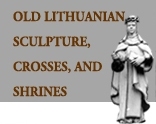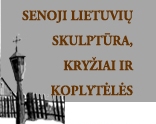LITHUANIAN
FOLK SCULPTURE IN
ALYTUS MUSEUM OF ETHNOGRAPY
Virtual
exhibition LITHUANIAN FOLK SCULPTURE IN ALYTUS MUSEUM OF ETHNOGRAPY
More and less famous experts
have always discussed Lithuanian Folk Sculpture as a material and
spiritual phenomenon. Different generations reconsider their roots. The
same can be said about our generation today as we move into the third
Millennium of the history of Christianity, and approach one thousand
years jubilee since the date when the name of Lithuania was mentioned in
written sources. We should also remember the continuous time flow.
Paulius Galaune (A Lithuanian ethnographer of the first half of the 20th
century) in his book published in 1930 was quoting with nostalgia the
ethnographers of the 19th century who had written about the many crosses
and chapels containing sculptures of saints that were situated along the
roadside about one hundred meters apart. We are not that lucky: though
the remains of sculptures, darkened by time and weather conditions, look
noble and mysterious, but trying to read them is like telling fortune
from coffee grounds. The collection of folk sculpture at Alytus Museum of
Ethnography is not very impressive by quantity or variety, but so far the
experts of this field and just curious people have not been familiar with
it. The aim of this modest work is to fill in the gap of information
about the cultural values kept in our museum.
The history of our seventy years old museum is full of obscurity and
puzzles. The oldest pre-war exhibits did not survive until the present
days. A "second breath" to the museum was given by Henrikas
Lizdenis, director of the museum in 1957-1976. This period could be
called a period of ruining of the old village and its customs. H.
Lizdenis collected some valuable ethnographic material, and made up a
collection of folk sculptures which later was supplemented by separate
exhibits. The Register Book of Received Exhibits says that the sculptures
were obtained in Alytus, Daugai, Lazdijai, and Varena districts of that
time from various village cemeteries and private people. Sometimes
inscriptions in the Register book contain very general information, e.g.
Alytus district, Motuizos (should be Matuizos); received from priest J.
Kausela (should be J. Kausyla) in Pivasiunai, etc. Just several names of
"God makers" are known: Julius Kopka who created the Crucifix
in the cemetery ofMikniunai village, Nedzinge country district; sculptors
from Daugai Patackas and his apprentice Julius Nevieras. Most often the
time of creation is not known. There are just a few dates mentioned in
the Register Book: e.g. "Unknown Saint, carved in 1890",
"Saint John Nepomuk, 1899", ect. The condition of the exhibits
is not very good.
Our sculptures used to stand in chapels of very simple shapes. Most
frequently, it was an ordinary open box of a trapezium shape, covered by
a triangle roof. Sometimes it had an imitation of a semicircle arch, and
columns. In order to protect the edges and roofs of the chapels from
atmospheric impact, they were covered by cut tin-plates. Sometimes the
plates were decorated by pressed-in and painted ornaments of flower
blossoms. Usually just one or two sculptures affected by time and weather
are left inside. The sculptures in the museum collection have lost their
location context, so we can only make guesses about the former sculpture
groups. The personalities of the sculptures do not vary much. Most of
them describe Crucifixes, Saint John Nepomuk, Our Lady, St. Florionus,
St. Anthony, etc. It is sometimes difficult to determine the personality
as most of them have been mined by time, and lost their symbolism. The
Register Books describe them as "Unknown saint". The museum
possesses two sculptures of a pelican tearing its chest and feeding its
youngsters. The sculptures are very different from the stylistic point of
view. Some of them have primitive archaic shapes, others are marked by
the hand of an experienced artist. For example, sculptures of Saint John
Nepomuk from Lazdijai and Simnas country-side districts have lively
baroque forms. A woman saint from Varena district, village Matuizos, with
a vertical prolonged falling of dress pleats, diagonal composition of
upper clothing, and the same position of hands reminds us of Gothic
sculptures of saints from Europe during the Middle ages. The body
postures, and facial expressions of some of the figures give accurate
characteristics of human personalities, and even depict their mood. Such
are unknown women saints from Lazdijai district, village Onciskes. The
collection contains several expressive crucifixes. Their authors tried to
express reality of nature, and material texture (e.g. thorniness of the
wrath, hair skeins stuck to the head, veins protruded because of strain).
That is why less attention was paid to the general picture of the body,
and relation between its separate parts. This is the reason why it is
possible to see combinations of naturalism, stylization, and
expressiveness in the same sculpture, which can be hardly compatible in
other places.
There is nothing new in saying that sculptures were painted. Some of them
have still preserved the remains of paint, while the others have faded
affected by bad weather and sun, but that makes them even more impressive
than being new. One should mention that the sculptures were constantly
repainted by any paint that was at hand, that is why some of them
acquired features of kitsch. Crucifix No 691 can be mentioned as an
example of the noble influence of wind and weather conditions to folk art
sculptures. The sculpture lost its hands, and the prolonged bodyline is
even more stressed by the crack in the wood in the chest area that is as
if rhythmically repeating the twisted direction of the head and face. As
the sculptures were meant to stand in the chapels of crosses, usually
their back side was left flat. The museum possesses several round
sculptures that can be viewed from all the sides. They are distinguished
by their size. The group of John the Baptist should be mentioned here.
The saint is holding a cross with a flag in his left hand, and pouring
holy water on Christ's head from a dish in his right hand. The faces of
the figures, and pleats of clothing are modeled accurately, the facial
expressions show great seriousness, the architectonics conveys the
solemnity of the moment. The hand of an artist and his inner elegancy can
be felt. These figures are quite large: Christ is 63 cm. Saint John the
Baptist is 70 cm high.
The exposition in the museum contains an impressive sculpture of Saint
John Nepomuk. The paint is well preserved, and the front side contains a
natural wood crack. The sculpture used to stand in village Kalesninkai,
Alytus district, at the farmstead of Zilinskai, on the bank of the little
river Perseke. At the end of 1968, in a morning it was found fallen down
on the ground. Even then the oldest inhabitants of the village did not
know anything about the time of its erecting, leave alone the name of the
author. They used to tell that Johnny (as the sculpture was called) had
come itself by the river.
To speak about folk wooden sculpture and not mention the magnificent
Crucifix, means like saying nothing at all. The sculpture is 163 cm
height, 160 cm width. It is best to look at it starting at the base up to
the top. It is monochromic, carved from solid wood, just the arms are
joined by wooden wedges. One can see the professional skills of the
artist, his knowledge of anatomy, and use of all the stylistic means for
a single purpose. The loin cloth is of a rare type, it is more often
found in Suvalkija region of Lithuania. The story of its appearance at
the museum is rather mysterious: the incorrect inscription about its
former location of finding was made for political purposes. As it
appeared later, the Crucifix was standing in the chapel of Mikaliske
village where post-war resistants used to bury their dead. A photograph
of 1960 shows a ruined chapel with the sculpture in it.
Other groups of sculptures were received later from Zemaitija region of
Lithuania. They used to stand in village Disliai, Alsedziai country-side
district, Plunge region. First, we would like to present a portable altar
describing the Crucifiction. This sculptural group consists of a
Crucifix, Our Lady in Grief, and women saints. Two figures of angels are
put on the horizontal cross-piece. The whole composition is Baroque, even
overcrowded, as if being afraid to leave any empty space. The altar is
polychrome as the remaining sculptures of that region. If we compare
these sculptures from Zemaitija with those from Southern Lithuania, we
will see that the former are much more realistic and more of everyday
life style than the latter. On the whole, sculptures from Dzukija
(Southern Lithuania) compared with others possessed by Alytus Museum of
Ethnography, can be distinguished by their big expressiveness, and
sincere feelings (typical national characteristics of this ethnic region
of Lithuania).
In summarizing, all the sculptures possessed by the museum, can be
divided by their authors into self-educated primitivists and craftsmen
specialized in this sphere. The first group raises almost no doubt:
"Traditional Baltic art is functional in the deepest sense as it
contains beauty and a practical side... and, without rivaling with God,
it reveals the spiritual status of the nation" (V. Daunys). Looking
at the sculptures it is obvious that their expression serves to the main
idea and purifies it in a certain way. "Primitive art melts in
itself incidental circumstances and stresses the way and purpose of
making..." (Claude Levi-Strauss).
The second group is represented by craftsmen who had some special
education in this sphere. At the beginning of this article I mentioned
the name of just one known to us author of primitive sculptures - Julius
Kopka. We have more knowledge about the authors of the second group. At
the end of the 19th century Simnas country-side district was famous for
craftsmen of sculpture and clerical attributes. One of them is Adomas
Karalius, who was born in Suwalki and mastered the Neogothic style. The
church attributes made by his apprentice J. Raciukaitis can still be
found in the churches of Nemunaitis, Miroslavas, Simnas, and others. The
sculptors A. Aleksandravicius and M. Mencinskas studied the skills of his
craft at famous craftsman M. Kasiulevicius from Ostampas village. The
latter himself, as well as his apprentices, strived to achieve high
labour culture, clean and technical finishing. Most of the authors of
this group studied their craft at Church Art schools of Poland.
In our work, we have met the so called problem of "ceiling".
For example, P. Galaune, and other art researchers of that time did not
consider the situation of "today" to be important. However,
their "today" for us is already yesterday. The works of the
authors of a more recent period are just imitations of what used to be
natural folk art. Our purpose is to show the folk sculpture such as it
will never again be created, as it has gone to the past together with the
whole epoch.
Kostas
Poskus

